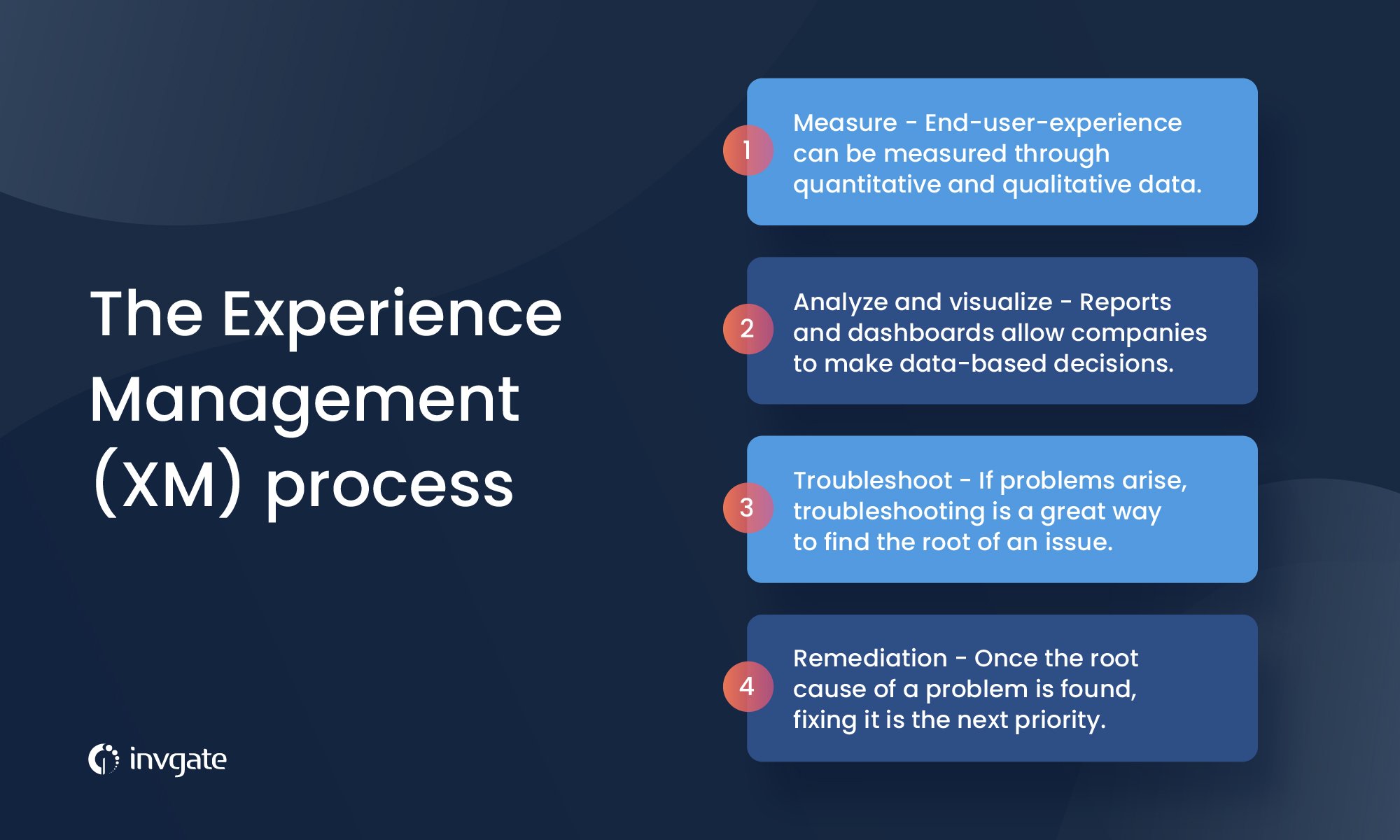Experience management (XM) is a term that has been in everyone’s mouths as of late. It has taken the IT world by storm and heralded it as a new and innovative way of viewing the relationship between customers, employees, and stakeholders.
Customer experience management and employee experience management have become integral to ITSM and the service industry. Hence, it was only a matter of time for experience management to become highly regarded in this data-driven and ever-expanding market.
This article will explore the concept of experience management, what it is, and why it has become so popular in recent years. We will also look at its benefits, how it works, and the 5 types of experience management implemented today.
Without further ado, let us dive deep into it.
What is experience management?
The origin of the term can be traced back to the year 1994. Steve Haeckel and Lou Carbone’s highly influential article titled “Engineering Customer Experiences” defined experience as “the ‘takeaway’ impression formed by people’s encounters with products, services, and businesses — a perception produced when humans consolidate sensory information.”
Nowadays, experience management could be better understood as tracking, analyzing, and improving all interactions people have with a company or business. It includes customers, vendors, employees, and stakeholders.
The experience itself could be defined as the perception and feelings of those who interact with a company. These experiences are then measured through quantitative and qualitative surveys and analytic tools to help companies make informed decisions on fine-tuning said experiences for all the people involved and meeting their business goals.
Why is experience management important?
As simple and plain as it sounds, the main reason why experience management is essential for companies is that businesses want to make customers and colleagues happy. Think about it, wouldn’t employees yield better results in their everyday tasks if they are satisfied with their experience at work? Wouldn’t customers and stakeholders feel more confident when investing in your product or vision if they can trust that the experience will be smooth, engaging, and effective?
Experience management starts to shine when you look at it as a significant element that requires monitoring just as much as other expenditures like electricity consumption or purchasing hardware assets for service desk agents, for instance.
Frequently companies find themselves in situations where they, of course, strive to do a good job and meet their SLAs but don’t bother to measure just how good of a job they did or if it worked to improve customer experience and employee satisfaction. Some even struggle to use their contact centers efficiently.
It’s no longer enough to provide a good service but also to ensure that the road that leads to it keeps all parties engaged and eager to continue engaging with it. There is a very insightful quote from business insider Alan Nance during an interview on Episode 11 of our tech podcast, Ticket Volume where, when prompted to talk about why experience management is garnering more attention than service management in the current IT landscape, he says:
“Experience management is very different from service management for one reason: humans. So, if I design an ultra-high availability network, it will work every day according to the KPIs I’ve set until something’s broken. If I design the best meal you’ve ever had but give it to you 5 days in succession, on day 6, you’ll say, ‘I’m done with this.’ So, people are self-programming sensors, meaning that experience management is more volatile than the underlying processes that support it.”
- Alan Nance, Co-Funder and President of XLA Collab.
This ultimately means that experience management’s importance hinges on the fact that people are not only buying just products but experiences, and employees are not just looking for a bigger paycheck but a work experience that they find fulfilling. It is all about balancing providing a good service or product and rendering the experience with it just as valuable.
3 benefits of experience management
The main reason why companies start their experience management journey comes down to a matter of business-related outcomes. As we have mentioned, happy customers tend to generate more revenue, and satisfied employees are often more productive and generally more engaged with their tasks. However, there are even more benefits to be found in experience management.
Such benefits include:
1. Improved recruiting and better employee retention
Nowadays, information about specific roles and general company information are not the only things on candidates’ minds when they are looking to apply for a position. They often consult business social media sites such as Glassdoor and Blind before deciding to use because a company’s reputation has become just as important as how much they are paying.
What’s more, a higher employee satisfaction tends to reduce turnover, and means that they’ll stick around for longer, perhaps even becoming recruiting agents if a company’s experience management is good.
2. Employee productivity and engagement
As we mentioned before, happy and satisfied employees will be more eager to work on their daily tasks. This has a direct impact on employee productivity and motivation, of course. It’s fair to say that highly productive employees greatly influence a business’s bottom line.
3. Overall enhanced business bottom line
Customers who feel like they have been heard are more likely to come back and spend more time with the company. Solid experience management is crucial in these instances because it leads to emotional investment from the customer’s side and an improvement in the customer journey, resulting in people who sing the praises of a service or product to other potential customers. All of this has a direct impact on a company’s financial goals.
4 types of experience management
It’s crucial to understand that the experience management’s objective can only be achieved if experience data and operational data converge to improve the 4 core experiences of business: Customer experience (CX), employee experience (EX), and product experience (PX), and brand experience (BX). Let us take a peek and learn what each one of these entails:
The customer experience (CX)
Customer experience is the sum of a customer’s feelings and perceptions when engaging with a company’s product or service. Customer experience begins when the customer purchases at the end of the customer interaction with the company. This is often referred to as the customer journey. It goes without saying that from the company’s point of view, good customer experience management leads to a renewal or repeat purchase of a product or service.
All brands provide customer experience, whether that experience is intended or not. Some do it in a centralized fashion through contact center platforms. The line between good customer experience management and lousy customer experience management is how well a company can encourage customer engagement through design experience and ease of use. The main goal is customer loyalty.
The challenging part when building a solid CX is that the customers behave table ways, and a superior product could be easily beaten by a lesser product just because customer experience was not considered. Thus, businesses should aim to optimize and assess every customer touchpoint to increase the likelihood of customer happiness and satisfaction. Customer experience management software is helpful as it allows companies to collect customer data and process it, provided the appropriate privacy statements are in place.
Employee experience (EX)
Employee experience is how a worker feels through their journey and the different touchpoints at a company. This begins at the job candidacy and ends when they exit the company. Components such as a company’s culture, technology and assets, and the workplace contribute to the employee experience.
As mentioned, good EX translates into better talent attraction and retention. Happy workers are likely to stay and provide good customer service. Happy workers are also expected to praise a company’s culture when they leave, thus improving its reputation for job-seekers looking to apply.
Product experience (PX)
Product experience focuses on the customer journey from purchasing the item or service to the last time they use it. It could also be considered a subset of the digital user experience. All the ways a customer interacts with the product or service contribute to the product experience. Usually, the product experience is tested out through free trials/samples or freemium business models, as customers can try out products before making a purchasing decision.
Companies that focus on PX embrace design thinking and foster innovation by putting themselves in the customer's shoes and looking at ways to make the product a more appealing choice over the competitors. So, product experience focuses on ensuring that products and services make users enjoy the journey of interacting with said product or service consistently.
Brand experience (BX)
Brand experience entails everything that goes through a customer’s mind when they think about a brand and its products and services. It’s all about the emotional and tangible experience they go through when they interact with a brand. It’s a mixture of customer service, product experience, and brand identity in one package.
An excellent example of a well-implemented BX is Coca-Cola. In many countries, the brand has become synonymous with family gatherings, kindness, bonding, and Christmas. A surefire way of knowing if a company provides a good brand experience is if its product or service has been associated with ideas, concepts, and emotions that don’t necessarily correlate to the product or service. This means that the brand has transcended, and it usually implies business and financial success.
How does experience management work?

The experience management process could be easily divided into 4 stages where a series of tasks must be carried out to ensure success. Let us break down each one of them.
1. Measure
The best way to measure end-end user experience effectively is through quantitative and qualitative data.
Qualitative data helps to better comprehend a customer’s attitude and sentiment towards a product or service, and helps shed some light on issues that would otherwise not come up. There is a myriad of surveying tools in the market that can be implemented in contact centers to gather employee and customer feedback.
Quantitative data is gathered through at least three distinct methods:
- Endpoint management tools help capture data such as the state of a device. For instance, a cellphone’s processor could be monitored to see how its current performance impacts customer service and experience.
- Application performance monitoring (APM) tools allow companies to know when certain apps slow down, crash or trigger errors in devices and software.
- Network monitoring tools track a network’s performance, health, and availability. Depending on a company’s needs, many protocols for network monitoring could be implemented to track different parts of a network’s traffic.
2. Analyze and visualize
After the data has been collected, businesses should find a way to analyze and visualize the data. This process is usually done through reports and dashboards. Companies looking for advanced actionable insight could implement tools that use machine learning models to provide net promoter scores or alert data analysts when a KPI exceeds its desired range. In turn, companies get to see what their environment looks like and can thus make decisions based on data rather than just an educated guess.
3. Troubleshoot
The next stage is to perform some troubleshooting to find the root of an issue in case a problem arises. In a worst-case scenario, this is done manually, which leads to a sluggish pace and often requires direct involvement from the end-user throughout the process. In other instances, the collected data is way too large, and an approach based on previous experiences is better to hasten the process.
4. Remediation
When the root cause of a problem has been found, fixing it is the next priority. In an ideal scenario, the issues can be solved by the user, and the company doesn’t even need to intervene. Automation and self-service workflows allow these issues to be solved by users, cutting costs and improving the overall customer experience.
Key takeaways
Experience management has become an integral part of the current IT landscape. It’s due to a shift from the service economy to the experience economy. We must keep motivating those involved in creating products and services and their consumption.
Experience management is composed of the 4 main experiences in business (CX, EX, PX, and BX), all of which work as moving parts to ensure customer satisfaction and employee satisfaction. And most importantly, we have broken down the process of implementing a successful experience management platform in a step-by-step guide format.
We are gearing towards a significant change in how we view products and services in the IT world. Experiences as a means of connecting with customers and employees have gained much popularity, and it is best to be well informed during its zeitgeist.















